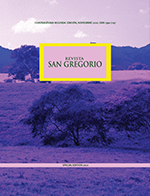Public control and counteraction to corruption offences by means of social communications and networks
Palabras clave:
Corruption, Corruption Offence, Public Organization, Public Institution, Social NetworkResumen
The research paper deals with identifying ways to strengthen the institutional capacity of citizens in the field of combating corruption and to create recommendations on measures to prevent corruption offenses. The genesis of criminologists' scientific opinion on the role of civil society institutions in the fight against corruption is analyzed. It is noted that scholars studied only fragments of the problem of public participation in the prevention of corruption offenses at different times. The study concerned only a general description of corruption offenses, their determination and ways of prevention, including, among others, the role played by NGOs in the anti-corruption process. When considering modern scientific research and international regulatory acts,Descargas
Referencias
Aidis, R., Estrin, S., & Mickiewicz, T. (2012). Size matters: entrepreneurial entry and government. Small Business Economics, 39(1), 119-139.
Assosiation for Psychological Science. (2017). When a “golden opportunity” to bribe arises, it’s hard to pass up. Retrieved from https://www.psychologicalscience.org/observer/when-a-golden-opportunity-to-bribe-arises-its-hard-to-pass-up
Banfield, E. (1958). The moral basis of a backward society. New York, NY: Free Press.
Beck, T., & Laeven, L. (2006). Institutional building and growth in transition economies. Journal of Economic Growth, 11, 157-186.
Becker, S., Boeckh, K., Hainz, C., & Woessman, L. (2016). The empire is dead, long live the empire! Long-run persistence of trust and corruption in the bureaucracy. The Economic Journal, 26(590), 40-74.
Capasso, S., & Santoro, L. (2018). Active and passive corruption: Theory and evidence. European Journal of Political Economy, 52, 103-119.
Corbacho, A., Gingerich, D., Oliveros, V., & Ruiz-Vega, M. (2016). Corruption as a self-fulfilling prophecy: evidence from a survey experiment in Costa Rica. American Journal of Political Science, 60(4), 1077-1092.
Della, P. D., & Vannucci, D. (2012). The hidden order of corruption: an institutional approach. Surrey, UK: Ashgate Publishing Limited.
Di Cagno, D., & Sciubba, E. (2010). Trust, trustworthiness and social networks: playing a trust game when networks are formed in the lab. Journal of Economic Behaviour & Organization, 75, 156-167.
Dreher, A., & Gassebner, M. (2013). Greasing the wheels? The impact of regulations and corruption on firm entry. Public Choice, 155, 413-432.
English, W. (2013). Institutional corruption and the crisis of liberal democracy. Edmond J. S. working papers, 15. Retrieved from http://dx.doi.org/10.2139/ssrn.2281305
Gorta, A. (2016). Corruption risk areas and corruption resistance. In C. Sampford, A. Shacklock, C. Connors, & F. Galtung (Eds.), Measuring corruption (p. 203-219). Burlinton, UK: Ashgate.
Granovetter, M. (1985). Economic action and social structure: the problem of embeddedness. American Journal of Sociology, 91(3), 481-510.
Granvovetter, M. S. (1973). The strength of weak Ties. American Journal of Sociology, 78(6), 1360-1380.
Heath, A., Richards, L., & de Graaf, N.-D. (2016). Explaining corruption in the developed world: the potential of sociological approaches. Annual Review of Sociology, 42, 51-79.
Kingston, C. (2008). Social structure and culture of corruption. Journal of Economic Behavior and Organization, 67(1), 92-102.
Klijn, E. H., Sierra, V., Ysa, T., Berman, E., Edelenbos, J., & Chen, D. Y. (2016). The influence of trust on network performance in Taiwan, Spain, and the Netherlands. International Public Management Journal, 29(1), 111-139.
Osifo, O. C. (2012). The effects of ethical governance on public trust: a comparative analysis of anti-corruption policies and procedures in Nigeria, Ghana, and Cameroon. Vaasa, Finland: University of Vaasa.
Pellegrini, L., & Gerlagh, R. (2008). Causes of corruption: a survey of cross-country analyses and extended results. Economics of Governance, 9(3), 245-263.
Scott, J. (1969). The analysis of corruption in developing nations. Comparative Studies in Society and History, 11(3), 315-341.
Shleifer, A., & Vishny, R. (1993). Corruption. The Quarterly Journal of Economics, 108(3), 599-617.
Social Progress Imperative (2020). Social progress index 2020. Retrieved from https://www.socialprogress.org/
Statista. (2019). Number of global social network users 2010-2023. Retrieved from https://www.statista.com/statistics/278414/number-of-worldwide-social-network-users/
Tidström, A. (2014). Managing tensions in coopetition. Industrial Marketing Management, 43, 261-271.
Transparency International (2019). Corruption Perceptions Index. Retrieved from https://www.transparency.org/en/cpi
Tzoumas, V., Amanatidis, C., & Markakis, E. (2012). A game-theoretic analysis of a competitive diffusion process over social networks. In P. W. Goldberg (Ed.), Internet and Network Economics (p. 1-14). Cham, Switzerland: Springer.
Uberti, L. (2016). The ‘sociological turn’ in corruption studies: Why fighting graft in the developing world is often unnecessary, and sometimes counterproductive. Progress in Development Studies, 16(3), 261-277.
Uberti, L. (2018). Corruption in transition economies: socialist, ottoman, or structural? Economic Systems, 42(4), 535-555.
United Nations. (2004). United Nations Convention against Corruption. Retrieved from https://www.unodc.org/documents/treaties/UNCAC/Publications/Convention/08-50026_E.pdf
United Nations. (n./d.). Principle ten: anti-corruption. Retrieved from https://www.unglobalcompact.org/what-is-gc/mission/principles/principle-10
Uslaner, E., (2017). Historical roots of corruption. Cambridge, UK: Cambridge University Press.
Verkhovna Rada of Ukraine. (2006). Criminal convention for the suppression of corruption (ETS 173). Retrieved from http://zakon0.rada.gov.ua/laws/show/994_101
We Are Social. (2019). Digital in 2019. Retrieved from https://wearesocial.com/global-digital-report-2019
World Bank. (2019). The World Bank annual report 2019: Ending poverty, investing in opportunity (English). Washington, DC: World Bank.















